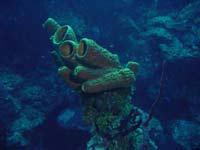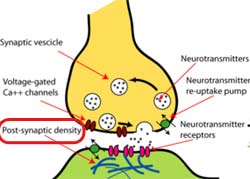
![]() Sponges are among the most primitive of all animals. They are immobile, and live by filtering detritus from the water. They have no brains or, for that matter, any neurons, organs or even tissues. If you were looking for the evolutionary origins of animal intelligence, you couldn't really pick a less likely subject to study.
Sponges are among the most primitive of all animals. They are immobile, and live by filtering detritus from the water. They have no brains or, for that matter, any neurons, organs or even tissues. If you were looking for the evolutionary origins of animal intelligence, you couldn't really pick a less likely subject to study.
 So it was with great surprise that Onur Sakarya from the University of California, Santa Barbara found that sponges carry the beginnings of a nervous system.
So it was with great surprise that Onur Sakarya from the University of California, Santa Barbara found that sponges carry the beginnings of a nervous system.
With no neurons to speak of, these animals still have the genetic components of synapses, one of the most crucial parts of our nervous system. And their versions share startling similarities with those of humans.
Synapses are junctions between two nerve cells that are allow them to pass signals to one another. These messages are carried by molecules called neurotransmitters that cross the synaptic gap. When they reach the receiving cell, they come across an elaborate tangle of proteins called the post-synaptic density (PSD; labelled in red below). The PSD processes the neurotransmitters, among many other important roles, and allows the receiving cell to respond appropriately to the nervous signal
Sakarya searched for equivalents of the human PSD proteins in the genomes of other animals. For a start, he found an almost complete set in the starlet sea anemone (Nematostella vectensis). The anemone (like its cousins, the jellyfish) is one of the Cnidarians, a group of animals that have the most rudimentary of nervous systems. Finding PSD genes in them is surprising but reasonable.
 But Sakarya was really surprised when he found the vast majority of the PSD assemblage in the sponge Amphimedon queenslandica, an animal that doesn't even have a nervous system! The sponge's PSD proteins bore remarkable resemblances to those of humans and other animals, and were built of similar arrangements of domains.
But Sakarya was really surprised when he found the vast majority of the PSD assemblage in the sponge Amphimedon queenslandica, an animal that doesn't even have a nervous system! The sponge's PSD proteins bore remarkable resemblances to those of humans and other animals, and were built of similar arrangements of domains.
One in particular, the PDZ domain, allows PSD proteins to recognise one another and assemble correctly. When Sakarya compared the structures of the human and sponge PDZ domains, he found that at the atomic level, the parts they used to interact with other proteins were almost 90% identical. So not only does the sponge have the full set of PSD proteins, in all likelihood, it can assemble them into a fully-functioning whole.
So what is the PSD, part of the nervous system, doing in an animal without one? Sakarya believes that the PSD is an example of exaptation, a process where evolution co-opts an existing structure for another purpose. Bird feathers are a good example of this - they evolved in small dinosaurs to help them regulate their body temperature, and were only later used for flight.
Exaptation can explain how complex, integrated structures like the nervous system can evolve. Rather than building the whole thing from scratch, evolution took 'off-the-shelf' components, like the PSD, and put them together in exciting new ways.
 The PSD of sponges is switched on in a type of cell called the 'flask cell'. Flask cells are only found in sponge larvae, which, unlike the adults, are free-swimming. These cells could help the larvae to sense their environment, and could well have been a starting point for the evolution of neurons.
The PSD of sponges is switched on in a type of cell called the 'flask cell'. Flask cells are only found in sponge larvae, which, unlike the adults, are free-swimming. These cells could help the larvae to sense their environment, and could well have been a starting point for the evolution of neurons.
Sakarya cautions that there could be another explanation. Sponges could be degenerate relics of a more advanced branch of animals, that stripped away their complexity in favour of life in the (very) slow lane. In this scenario, the flask cells are evolutionary remnants of neurons proper.
Nonetheless, under both scenarios, these findings strongly suggest that the common ancestor of all living animals already has an early working version of the PSD, that effectively pre-adapted it for the evolution of nervous systems. With minimal additional evolutionary steps, this early scaffold could have been transformed into the functional synapses that drive our thoughts today. The ancestor was pre-adapted to a future with neurons.
It's worth noting that this discovery was only made possible because the genome of Amphimedon has been fully sequenced. In an age where genome sequencing could start to be taken for granted, this drives home the importance of sequencing a wide variety of living things that represent crucial junctures in evolution.
Reference: Sakarya, Armstrong, Adamska, Adamski, Wang, Tidor, Degnan, Oakley & Kosik. 2007. A post-synaptic scaffold at the origin of the animal kingdom. PLOS One 6, e506: 1-7.
More on exaptation:

I am really interested in this, as I have heard people discuss whether 'less developed' animals can feel pain or anything else. I wonder if this kind of research will help clarify that, and also shed some light on the nature of our own nervous systems.
Wow. It's just so fascinating--the way the same element of existence runs through such diversity of life.
Ooh, I can hear the "frontloading" arguments powering up at the DI already.
But seriously, fascinating post, as always.
Actually, I don't find this at all surprising. Even yeast have the basic cell biological machinery required for presynaptic function, and there are a number of PDZ proteins--including those referred to by the "D" and "Z" in PDZ--that have functions unrelated to the nervous system.
It seems evolution is in some sense deeply conservative -- using the same building blocks over and over again. Fascinating post, Ed!
Doesn't "pre-adapted" infer some sort of "look ahead" feature in the evolutionary scheme? I didn't think that occurred in the natural selection process due to the "blind watchmaker" sort of adaptation. Am I misreading your intent with that phrase?
What amazed me most is 'proteins were almost 90% identical'. Maybe in far far far away future we are able to transplant organs prepared from sick's cells that cover frame made out of plant's structure. This way no animal or donor is needed to save others life. Just make a good use of this findings!
This is cool, but I remember reading about it in an old basic neuroanatomy book (Nauta's) that was published in the early 90s, I think.
Although this is an intriguing spin I hadn't thought of: "Sponges could be degenerate relics of a more advanced branch of animals, that stripped away their complexity in favour of life in the (very) slow lane. In this scenario, the flask cells are evolutionary remnants of neurons proper."